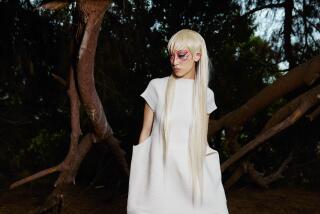Review: At USC Pacific Asia Museum, portraits of actors done the Tsuruya Kokei way
Manga, anime and other sensations of 1990s pop culture made cosplay a fashionable pastime, but before that happened there was Tsuruya Kokei.
An artist working at Tokyo’s renowned Kabukiza Theater, home to the highly stylized art of classical Japanese drama, Kokei made portraits of the all-male Kabuki actors decked out in the costumes and makeup of their most famous roles. The woodblock prints, a kind of high-end form of baseball cards or celebrity magazine pictures, could be acquired by fans. The imagery is the artist’s own highly stylized spin on the actors’ already abstracted appearance.
At Pasadena’s USC Pacific Asia Museum, 89 woodcuts and drawings survey this distinctive body of work in a handsomely organized and installed exhibition. “Tsuruya Kōkei: Modern Kabuki Prints Revised & Revisited,” the artist’s second solo show at the museum, is an anniversary marker. The first took place 30 years ago, itself marking a centennial — the Kabukiza Theater’s 100th year.
This generational layering of anniversaries reflects Kabuki’s own deep commitment to tradition. Formal continuity with the past is held in tension with an actor’s uniquely individual interpretation of a role in the present. Kokei’s portraits add another tier.
Most are portrait busts, but some figures are shown full-length. Flat, sometimes transparent color creates pictorial space through layered patterning. Kabuki makeup employs stark, thick linearity to emphasize facial features — the flare of a nostril, the furrow of a brow — which Kokei adapts for pictorial drama in his compositions.
The artist typically positions the actor against a blank, unprinted expanse or a background in a solid color. Sometimes, the ground includes softly light-reflective mica, a technique borrowed from Toshusai Sharaku, a venerated late-18th century predecessor about whom little is known. (Three works by Sharaku, printed in the 1940s from original blocks, are also on view.) Unusual for the genre, Kokei not only designs the image but cuts the soft, magnolia-wood block and does his own printing — jobs usually handed off to technicians.
A theatergoer likely knows the story being enacted already, so a central part of the pleasure of the ritualized performance is in watching for the ways an actor chooses to portray the role. Ditto Kokei’s prints. For the uninitiated, guest curator Kendall Brown and his students at Cal State Long Beach have included helpful extended labels in several places, as well as video clips.
One describes Kiyohime, a jealous young beauty from Japanese folklore. She pursued an unfaithful lover, who was escaping by boat, by swimming across a raging river and transforming herself into a deadly serpent.
Kokei nudges a subtly monstrous undercurrent from the actor’s portrayal of an otherwise lovely, willowy maiden. The rhythmic lines of her torqued, twisting body and the rippling waves of her loosened hair could be aptly described as serpentine. Even her artfully curled fingers seem to slither.
Benkei, fictional offspring of a temple god, is a morally ambiguous role famously played by Nakamura Kichiemon II, a so-called Living National Treasure in Japan. Kokei’s lush but colorless portrait of the intense, Buddhist warrior-monk is rendered in rich shades of white, gray and black. His hulking body, toothsome grin and flashing eyes are pushed up close to the picture-plane; he fills the frame, dominating the visual field.
The revered place in the Kabuki pantheon of both the character and the actor is italicized by Benkei’s oversized right hand, held upright before him. It reaches more than half the printed sheet’s height. The sly gesture, ring finger brought to meet the thumb, hovers somewhere between a Sanskrit mudra — a ritualized hand-sign with esoteric meanings — and an Orthodox Christogram familiar from medieval European depictions of Jesus.
The exhibition also includes sections that compare Kokei’s work to earlier, historical examples of Kabuki portraiture and, more generally, the interest in Japanese theatrical stylization in recent pop culture and art, including toys and graffiti. (Notably, the deft L.A. painter Gajin Fujita reconfigures a New Orleans Saints football player as a ferocious Kabuki hero.) But it is Kokei who stands out.
In a pencil self-portrait from 2010, drawn when he was 64, the artist framed his piercing eyes in round eyeglasses staring intently into the unseen mirror necessary to produce his own likeness, and he thrust out his own hand before it, open palm upraised. Kokei’s acutely rendered head seems almost to rest in that masterfully drawn hand.
Considered thought is conveyed through an artist’s manual proficiency, and he offers it to a curious viewer.
USC Pacific Asia Museum, 46 N. Los Robles Ave., Pasadena. Wednesdays-Sundays, through July 14. (626) 449-2742, www.pacificasiamuseum.usc.edu/
More to Read
The biggest entertainment stories
Get our big stories about Hollywood, film, television, music, arts, culture and more right in your inbox as soon as they publish.
You may occasionally receive promotional content from the Los Angeles Times.







